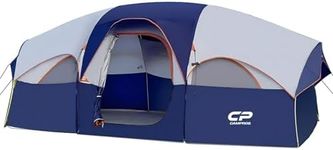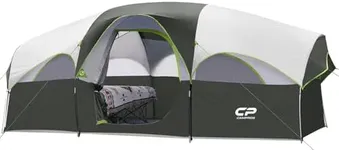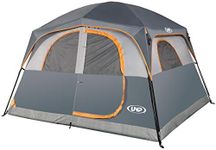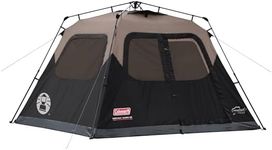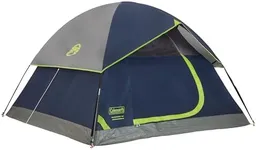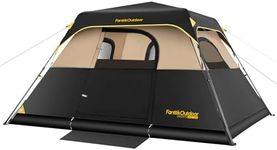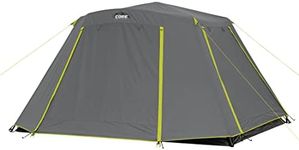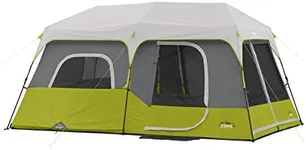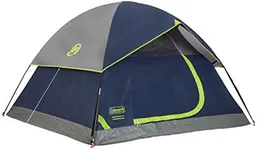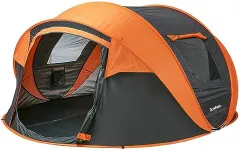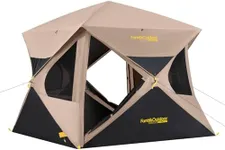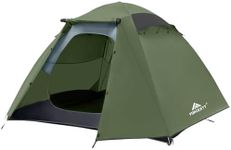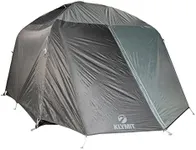Buying Guide for the Best Camping Tents
Choosing the right camping tent is all about matching your shelter to the kind of camping you plan to do. Tents come in many shapes, sizes, and materials, each suited to different weather conditions, group sizes, and comfort preferences. You’ll want to think about where you’ll be camping, how many people (and gear) will be inside, and what type of camping you’ll do — whether it’s backpacking, car camping, family vacations, or festivals. By focusing on a few key features, you’ll be able to pick a tent that gives you comfort, protection, and convenience on all your outdoor adventures.CapacityCapacity refers to how many people a tent is designed to sleep. This spec is important because it determines if everyone in your group (and possibly your gear) fits comfortably inside. Tent capacity is usually listed as a number of people, but this is often a tight fit with minimal personal space. If you value extra comfort or have a lot of gear, you might want to size up. For solo trips or ultralight backpacking, a 1-person or 2-person tent keeps things light and compact. Couples or close friends may be fine with a 2-person tent, while families or groups will want to look for tents built for 4 people or more. Think about how much space you’ll want inside and how much personal space you need, then pick accordingly.
Season RatingSeason rating tells you what kind of weather the tent is made to handle, usually listed as 2-season, 3-season, or 4-season. This is crucial because it determines how well the tent will protect you from rain, wind, and temperature changes. 2-season tents are good for mild weather in late spring or summer. 3-season tents are the most common and versatile, built to handle most weather from spring through fall — they resist rain, deal with wind, and provide ventilation. 4-season tents are for harsh winter conditions with snow and strong winds. Choose a tent with a season rating that matches the weather you expect on your trips. Most campers will do fine with a 3-season tent unless they plan winter camping.
WeightWeight is especially important if you’ll be carrying your tent in a backpack. This spec tells you how heavy the tent is when packed. There’s a range: ultralight tents for backpacking can be under 2 kg (4.5 lbs), while larger family or car camping tents may weigh several times more. Lightweight tents are best for hiking or carrying long distances, even if they have less interior space and fewer features. Heavier tents are fine for car camping, where weight is less of an issue and comfort or space becomes more important. Decide how much you can comfortably carry and balance that with the comfort and features you want.
Setup and DesignSetup and design cover how easy it is to pitch the tent and the shape or style it comes in. Freestanding tents don't need to be staked down to stand up, making them quick to set up and move around, while non-freestanding options are usually lighter but take more effort to pitch. Dome and cabin shapes are common — dome tents are better at shedding rain and wind, while cabin tents maximize headroom. If you’re a beginner or value easy setup, look for a tent that’s labeled quick or instant setup. Think about how much time and effort you want to put into setting up and taking down your tent when choosing.
Weather ProtectionWeather protection includes features like rain flies (outer waterproof layers), strong floors, and sturdy poles. These features keep you dry and stable during storms. The rain fly is especially important — full-coverage rain flies offer better protection during heavy rain, while partial rain flies give more ventilation. A good bathtub floor that curves up at the edges helps prevent water from seeping in. For windy or stormy areas, argue for a tent with strong and flexible poles, guy lines, and reinforced seams. Choose based on the kind of weather you might face — the wetter and windier, the more important this spec becomes.
VentilationVentilation is all about how well air can move through the tent to reduce condensation and keep you comfortable. Good tents have mesh panels, windows, or vents to let air in and out. This is especially important in warm, humid conditions or when several people are sleeping inside the tent. If you camp mainly in summer or humid locations, prioritize tents with large mesh areas and adjustable vents. In colder conditions, you still want some ventilation to prevent condensation on the inside walls.
Packed SizePacked size is the amount of space the tent takes up when it’s folded down and stored. This matters if you have limited space in your backpack, car, or storage at home. Smaller packed sizes are valuable for backpackers or anyone needing to save space, while car campers may be less concerned about this. Check the packed size and compare it to your carrying or storage needs — if you have a small backpack or need to fit several tents and gear in your car, a more compact tent will serve you better.
